Why Ivy Bridge Is Still Quad-Core
by Kristian Vättö on December 5, 2011 1:35 PM EST- Posted in
- CPUs
- Intel
- Ivy Bridge
A couple days ago, we published our Ivy Bridge Desktop Lineup Overview in which we mentioned that Ivy Bridge will remain a quad-core solution. There are dozens of forum posts with people asking why there's no hex-core Ivy Bridge, so now seems like a good time to address the question. Fundamentally, Ivy Bridge is a die shrink of Sandy Bridge (a "tick" in Intel's world), and that usually means either the core count or frequency is increased due to the lower power consumption of the smaller process node. Thus, instead of hex-core, we get a chip that looks much the same as a year-old Sandy Bridge, only with improved efficiency and some other moderate tweaks to the design. Let's go through some of the elements that influence the design of a new processor, and when we're done we will have hopefully clarified why Ivy Bridge remains a quad-core solution.
Marketing
If we look at the situation from the marketing standpoint first, having a hex-core Ivy Bridge die would more or less kill the just released Sandy Bridge E. Sure, IVB is about five months away, but I doubt Intel wants to relive the Sandy Bridge vs. Nehalem (i7-9xx) situation--even Bloomfield vs. Lynnfield was quite bad. If Intel created a hex-core IVB die, they would have to also substantially cut the prices of SNB-E. The current cheapest hex-core SNB-E is $555, while IVB hex-core would most likely be priced at $300~$400 since it's aimed at the mainstream; otherwise very few SNB-E systems would be sold. Even then, most consumers would opt for the IVB platform due to cheaper motherboard costs and lower TDP. PCIe 3.0 should also make 16 lanes fine for dual-GPU setups, reducing the market for SNB-E even more.
Differentiating the lineup by keeping Ivy Bridge quad-core allows some market for SNB-E among enthusiast consumers. Ivy Bridge E isn't coming before H2 2012 anyway so SNB-E must please the high-end until IVB-E hits. In the end, we still recommend SNB-E primarily for servers and workstations where the extra memory channels, PCIe lanes, and dual-socket support are more important, but the lack of hex-core IVB parts at least gives the platform a bit more of an advantage.
Evolution from traditional CPU to SoC
There are more than just marketing reasons, though. If we look at the following die shots, we can see that CPUs are becoming increasing similar to SoCs.

Quad-core Kentsfield package (2006)

Quad-core Nehalem die (2008)
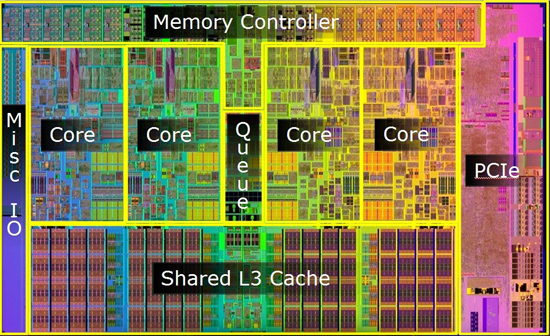
Quad core Lynnfield die (2009)
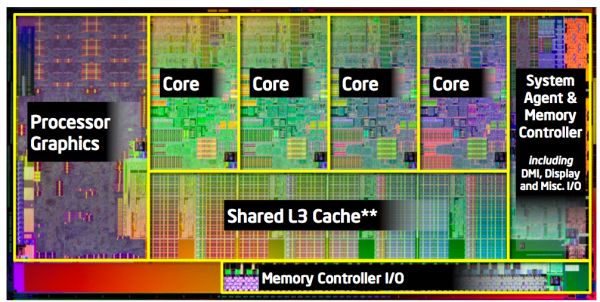
Quad-core Sandy Bridge die (2011)
These four (well, techically three because Kentsfield consists of two dual-core Conroe dies) chips are the only "real" quad-core CPUs from Intel. There are quad-core Gulftown Xeons, and there will soon be quad-core SNB-E CPUs, but they all have more cores on the actual die; some of them have just been disabled. Comparing the die shots, we notice that our definition of CPU has changed a lot in only five years or so. Kentsfield is a traditional CPU, consisting of processing cores and L2 cache. In 2008, Nehalem moved the memory controller onto the CPU die. In 2009, Lynnfield brought on-die PCIe controller, which allowed Intel to get rid of the Northbridge-Southbridge combination and replace it with their Platform Controller Hub. A year and a half later, Westmere (e.g. Arrandale and Clarkdale) brought us on-package graphics--note that it was on-package, not on-die as the GPU was on a separate die. It wasn't until Sandy Bridge that we got on-die graphics. The SNB graphics occupy roughly 25% of the total die area, or the space of three cores if you prefer to look at it that way, and IVB's graphics (a "tock" on the GPU side, as opposed to a "tick") will occupy even more space.
While we don't have a close-up die shot of Ivy Bridge (yet), we do know its approximate die size and the layout should be similar to the Sandy Bridge die as well. Anand estimated the die size to be around 162mm^2 for what appears to be the quad-core die (dual-core SNB with GT2 is 149mm^2, and even with the more complex IGP we wouldn't expect dual-core IVB to be larger). That's a 25% reduction in the die size when compared with quad-core SNB die (216mm^2). A 22nm quad-core SNB die would measure in at 102mm^2 with perfect scaling and assuming all the logic/architecture is the same; however, scaling is never perfect and we know there are a few new additions to IVB, so 162mm^2 for IVB die sounds right. Transistor wise, IVB counts in at around 1.4 billion, a 20.7% increase over quad-core SNB.
To the point, today's CPUs have much more than just CPU cores in them. We could easily have had a hex-core 32nm SNB die at the same die size if the graphics and memory controller were not on-die .We've actually got a pretty good reference point with SNB and Gulftown; accouting for the larger L3 cache and extra QPI link, Gulftown checks in at 240mm^2, though TDP is higher than SNB thanks to the extra cores. The same applies to Ivy Bridge. If Intel took away the graphics, or even kept the same die size as SNB, a hex-core would be more or less given. Instead, Intel has chosen to boost the graphics and decrease the die size.
Subjectively, this is not a bad decision. Intel needs to increase graphics performance, and will do just that in IVB. Intel's IGP solutions account for over 50% of the PC marketshare, yet the graphics are their Achilles' Heel. All modern laptops have integrated graphics (though many still opt to go discrete-only or use switchable graphics), and having more CPU cores isn't that useful if your system will be severely handicapped by a weak GPU. We've also shown in numerous articles how hex-core scaling over quad-core is largely unnecessary on desktop workloads (more on this below). Increasing the graphics' EU count and complexity while also adding CPU cores would have led to a larger than ideal die, not to mention the increased complexity and cost. Remember, Moore's Law was more an observation of the ideal size/complexity relationship of microprocessors rather than pure transistor count, and smaller die sizes generally improve yields in addition to being less expensive.
Performance
While six cores is obviously 50% more than four cores, the increase in cores isn't proportional to the increase in performance. More cores put off more heat and hence clock speeds must be lower, unless the TDP is increased. Intel couldn't have achieved the 77W TDP at reasonable clock speeds if Ivy Bridge was hex-core. On top of that, there is still plenty of software that is not fully multithreaded or fails to scale linearly with core count, so you would rarely be using all six cores (plus six more virtual cores thanks to Hyper-Threading). More cores will only help if you can actually use them, while higher frequencies universally improve performance (all other things being equal). We can give some clear examples of this with a few graphs from our Sandy Bridge E review.
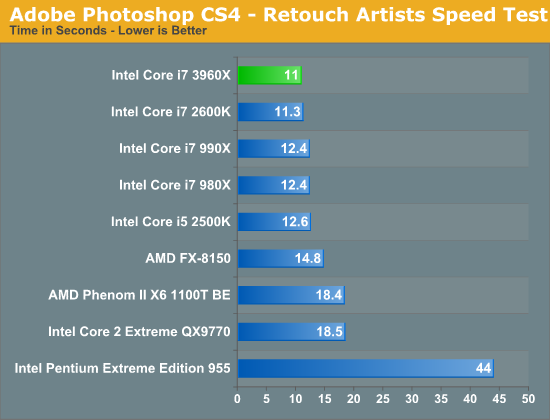
Photoshop is a prime example of software that has limited multithreading. We used the older CS4 in our tests, but CS5 isn't any better, unfortunately. Photoshop can actively take advantage of four threads, and thus the hex-core i7-3960X isn't really faster than quad-core i7-2600K. The slight difference is most likely due to the difference in Turbo (3.9GHz vs 3.8GHz) or the quad-channel vs. dual-channel memory configuration. There are also a few peaks where more than four threads are used, thus i7-2600K is faster than i5-2500K thanks to Hyper-Threading, on top of the extra cache and higher Turbo of course.
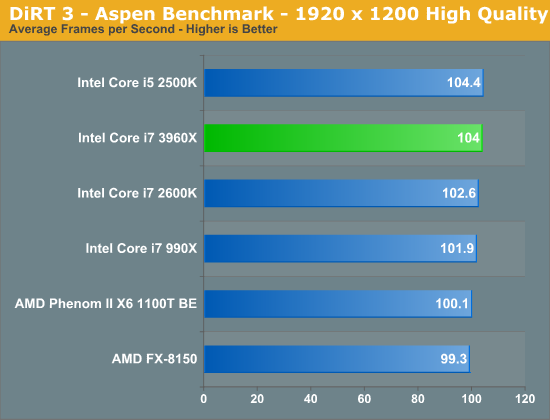
In general, games are horribly multithreaded. DiRT 3 is an example of a typical game engine, and adding more cores and enabling Hyper-Threading actually hurts the performance. There are only a handful of games that benefit from more cores, although there are still obstacles to overcome even then (see below).
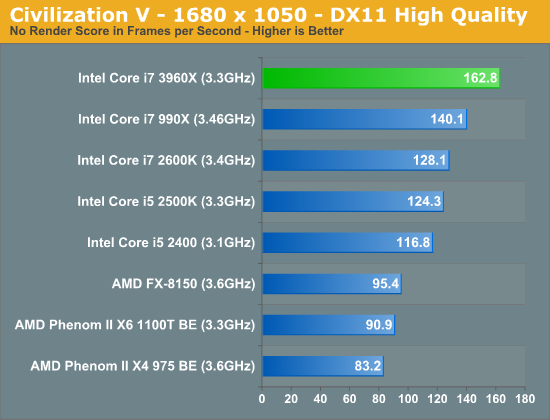

Civilization V fits in the handful of games that can scale across multiple cores. However, you will still be bottlenecked by your GPU in GPU bound scenarios (like in the second graph), which makes the usefulness of more cores questionable in this case. It's irrelevant whether you get 60 or 120 FPS in CPU bound scenarios if the real gaming performance is ultimately bound by your GPU speed.
The above graphs are biased in the sense that they are for tests where SNB-E is roughly on-par with regular quad-core SNB. However, keep in mind that we are comparing 130W hex-core and 95W quad-core; a 77W hex-core part might need lower clock speeds and could perform worse in limited-threaded tasks (depending on the Turbo speeds of course). In general, tasks like video encoding, 3D rendering, and archiving scale well with additional cores, but how many consumers run these tasks on a day-to-day basis? If you know you will be doing a lot of CPU intensive work that can benefit from additional cores, SNB-E (and later IVB-E) will always be an option--though you'll give up Quick Sync and the integrated graphics in the process. For most consumers, higher frequencies will likely prove far more useful due to the limited multithreading of everyday applications.
There is also the AMD point of view. Bulldozer hasn't exactly been a success story and there is no real competition in the high-end CPU market because of that. Intel could skip Ivy Bridge altogether and their position at the top of the performance charts would still hold. With no real competition, there's no need to push the performance much higher. Four cores is enough to keep the performance higher than AMD's, and reducing the TDP as a side effect is a big plus, especially when thinking about the future and ARM. As another point of comparison with AMD, look at Llano: it's a quad-core CPU that focuses more on improved graphics. For example, the now rather "old" Lynnfield i5-750 (quad-core, no Hyper-Threading) is able to surpass the CPU performance of Llano, but that hasn't stopped plenty of people from picking up Llano as an inexpensive solution that provides all the performance needed for most tasks.
Wrap-Up
When looking at the big picture, there really aren't any compelling reasons why Intel should have gone with hex-core design for Ivy Bridge. Just like the Sandy Bridge vs. Gulftown comparison, IVB vs. SNB-E looks like a good use of market segmentation. Sure, some enthusiasts will argue that having a quad-core CPU is so 2007, but don't let the number of cores fool you. The only thing that 2007 and 2012 quad-cores share is the core count; otherwise they are very different animals (see for example i7-2600K vs Q6600). It also appears that even without additional cores or clock speed improvements, Ivy Bridge will be around 15% faster clock for clock than Sandy Bridge (according to Intel's own tests; a deeper performance analysis will come soon).
Increasing the frequencies and boosting the clock for clock performance yields increased performance in every CPU bound task, and improving the quality of the on-die graphics helps in other areas. In contrast, increasing the core count only helps if the software has proper multithreading and can scale to additional cores--both of which are easier said than done. Given all of the possibilities, it would appear that Intel has done the right thing, and in the process there's no need to try and convince consumers into believing that they need more cores than they actually do.










79 Comments
View All Comments
Roland00Address - Monday, December 5, 2011 - link
Ivybridge is going to be intels first mass production of 22nm chips, when you are doing a new manufacturing process you do not mess with the design and make it more complicated than you have to, if you screw it up you will have crappy yields and crappy yields means loss money. Graphic cards and SoC manufactures call this a "pipe cleaner", intel calls it a "tick."Once you know your manufacturing technique, once you sure of it and yields are great, then you get all creative and do your planned monster (what intel calls a "tock".)
Intel not needing to release a 6 core for most mainstream users do not benefit due to software, and amd not providing enough competition thus a mainstream 6 core cannibalize their high end and reducing profit is just gravy.
LV3 - Monday, December 5, 2011 - link
Although Intel is still making great improvements, I can't help but think it's not as good as it could be because the main reason imo the Intel execs are holding the leash back on their engineers is because they would be competing with their own processors.Here, Intel is competing with itself. If AMD was at all a threat, Intel would have no qualms about making Ivy Bridge even better.
IntelUser2000 - Monday, December 5, 2011 - link
This is actually most, if not ALL due to ARM. In 2008, Haswell was slated to bring 8 cores to mainstream computing. Now its 4. This year they announced significant strategy change to lower power across the entire product line. That's what's happening now. Haswell will still get all the performance clock and other improvements, but not the extra core count(maybe in the high end, but not for vast, vast majority).Ananke - Monday, December 5, 2011 - link
Intel just doesn't need to offer a 6-core IB, because it has no competition. Instead, Intel will have double profit margins due to the smaller die, and will sell at the current or slightly higher prices of SB analogs. Customer is happy - he gets 10-20% performance increase; Intel is happy - it gets 50-60% margin increase :):):).plague911 - Monday, December 5, 2011 - link
I want a a cpu at roughly 200~300I want a discrete graphic card in the 200-300 range
and I want pcie 3.0 and usb 3.0
I can get an ivy or sandy bridge chip with integrated gfx which I find a waste of money
Or I can splurge on a $500 sandy ex and get a 6 core which wastes money because many programs do not support that many threads so the splurge is not worth it.
So ya intel is forcing me into into a buying situation where I am not being offered where i want.
Yes I am being selfish buy I assume others are in the same position as me.
This is what happens when AMD becomes a failure on the consumer front :(
kyp275 - Monday, December 5, 2011 - link
Wonder if it'll be worthwhile to upgrade to Ivy Bridge from Bloomfield for gaming purposes... might be worth it for the reduced TDP and more OC overhead, even if there's no huge performance jump?Shadowmaster625 - Monday, December 5, 2011 - link
That's the technical term for it. Milking. Intel is doing it because they can. That's clearly what they're doing with the new atoms. They wont release the new atom because they know it will castrate their CULV chip sales. They know that all 99% of notebook users needs are met with pentium B950. If an atom even comes close to matching that in cpu and gpu performance, they're yoy revenues will go down. Cant let that happen. Of course its gonna happen anyway, but they can extend and pretend for quite a while.drbaltazar - Tuesday, December 6, 2011 - link
intel:they release a new idea say in 2010 ,then at their next evo they insanelly polish that idea!amd work differently they dont die shrink as often as intel but they do polish their way more often then intel that is why at time amd look like its behind (any remember when 45 nm was released and then later they polished it to x6 wich is surprisingly good
only reason intel looks like it is ahead is because amd is using lot of futur stuff.(fma4,xop,the way the cache work isnt supported by w7 neither is a lot of other stuff made from amd fx,even when w8 is released a lot of stuff still wont be supported or plain mainstream.we ll have ways to test fma4 but average program optimise for it?unless ms optimise THEIR full program for the various toy amd made avail i dont see how it can happen ,as for intel fma3 is a long way in the futur,fma4 nobody knows.at 1080p 23 inch a bottleneck occur be it on intel or amd it is impossible for both proc to be so close they re within margin of error.so something is limiting(probably on the mobo side (they tend to be slow to adopt )or elsewhere.one thing is sure.i ve beeen using computer since the 80s and it never happen to be within the margin of error like this.lot of people are looking into this on both side of the fence(probably why fx sell so many darn proc ,often out of stock.one thing is sure this situation has to be found out before w8 release .one thing is sure a lot of people just upgraded smaller and will forgo this gen (fx)espacially with the x6 at 140 and the 980 at 90 on amd site.most will do a serious upgrade once they know why intel and amd are within margin of error in so many test!
beginner99 - Tuesday, December 6, 2011 - link
...why some people think this is an intel biased site. Of course the mentioned points make sense but why is Ivy bridge threatening SNB-E? Because SNB-E is a crippled E platform. only 2 Sata-3 ports? Seriously? and the total count of 6 sata ports is rather low too. I have a 1156 (lynnfield) and use 6 ports. I mean just a default ssd+ HDD + optical already uses half of the ports.JarredWalton - Tuesday, December 6, 2011 - link
Okay, I'll bite: what does any of that have to do with us being "Intel biased"? We list marketing (market segmentation as well) as a reason why IVB is quad-core and that makes us Intel biased? Hmmm....